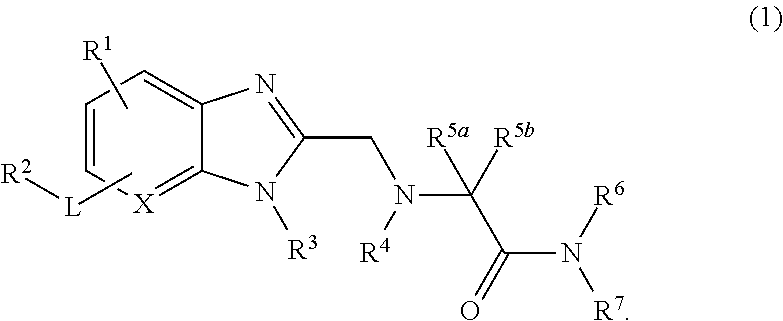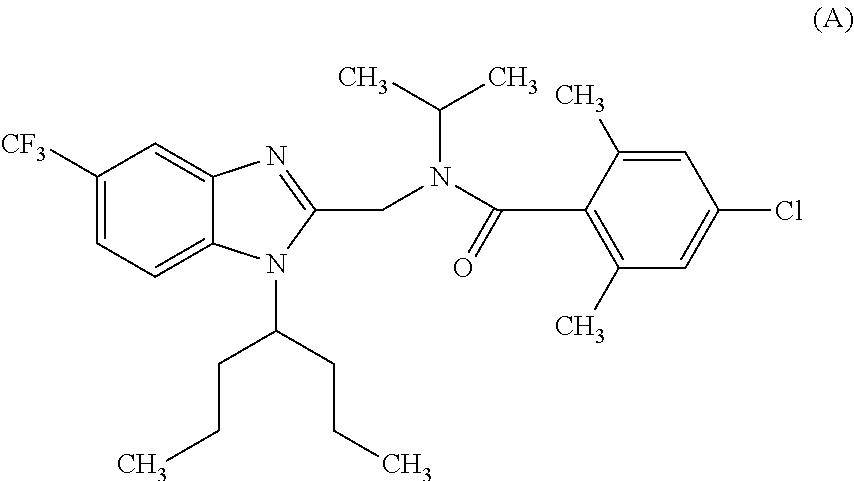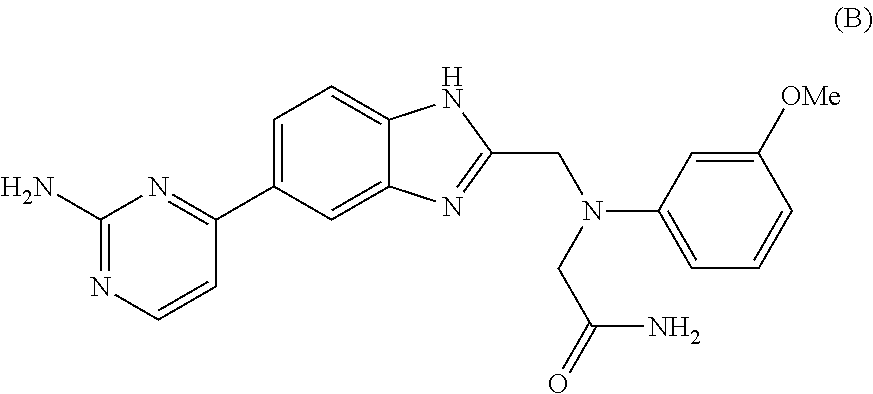Bicyclic heterocyclic compound
a bicyclic heterocyclic and compound technology, applied in the field of pathology treatment or prophylaxis, can solve the problems of drug resistance, ineffective neuropathic pain opioids such as morphine and the like, and the side effects of systemic administration remain a problem, and achieve the effect of treating or prophylaxis of pathology
- Summary
- Abstract
- Description
- Claims
- Application Information
AI Technical Summary
Benefits of technology
Problems solved by technology
Method used
Image
Examples
reference example 1
[0273]
[0274]To a solution of 2,4-difluoronitrobenzene (15 g, 94 mmol) in dioxane (300 mL) were added potassium carbonate (14.4 g, 104 mmol) and 2-ethoxyethylamine (8.4 g, 104 mmol), and the mixture was stirred at room temperature overnight. Water was added to the reaction mixture, and the mixture was extracted with ethyl acetate. The organic layer was washed with water and saturated brine, dried over sodium sulfate, and concentrated under reduced pressure to give the object product (21 g, 98%).
[0275]1H-NMR (CDCl3) δ 1.25 (t, J=7.1 Hz, 3H), 3.43 (q, J=5.2 Hz, 2H), 3.58 (q, J=7.1 Hz, 2H), 3.72 (t, J=5.2 Hz, 2H), 6.37 (ddd, J=9.5, 7.3, 2.5 Hz, 1H), 6.51 (dd, J=11.5, 2.5 Hz, 1H), 8.22 (dd, J=9.5, 6.1 Hz, 1H), 8.38 (br, 1H).
reference example 2
[0276]
[0277]To a solution (60 mL) of the compound (3.0 g, 13.2 mmol) obtained in Reference Example 1 in dioxane were added cesium carbonate (6.4 g, 19.7 mmol) and phenol (1.5 g, 15.8 mmol), and the mixture was heated to 80° C. After stirring for 7 hr, water was added to the reaction mixture, and the mixture was extracted with ethyl acetate. The organic layer was washed with water and saturated brine, dried over sodium sulfate, and concentrated under reduced pressure to give the object product (4.1 g, 100%).
[0278]1H-NMR (CDCl3) δ 1.23 (t, J=7.0 Hz, 3H), 3.34 (q, J=5.2 Hz, 2H), 3.55 (q, J=7.0 Hz, 2H), 3.67 (t, J=5.2 Hz, 2H), 6.22 (dd, J=9.4, 2.5 Hz, 1H), 6.29 (d, J=2.5 Hz, 1H), 7.07-7.12 (m, 2H), 7.23 (m, 1H), 7.35-7.45 (m, 2H), 8.16 (d, J=9.4 Hz, 1H), 8.39 (br, 1H).
reference example 3-1
[0279]
[0280]To a solution (50 mL) of the compound (1.8 g, 6.0 mmol) obtained in Reference Example 2 in ethanol was added 10% palladium-carbon (1 g), and the mixture was stirred at room temperature for 4 hr under a hydrogen atmosphere. The reaction mixture was filtered through celite, and the filtrate was concentrated and dried under reduced pressure to give the object product (1.4 g, 86%).
[0281]1H-NMR (CDCl3) δ 1.22 (t, J=7.0 Hz, 3H), 3.21 (t, J=5.2 Hz, 2H), 3.23 (br, 2H), 3.53 (q, J=7.0 Hz, 2H), 3.67 (t, J=5.2 Hz, 2H), 6.34 (dd, J=8.3, 2.6 Hz, 1H), 6.40 (d, J=2.6 Hz, 1H), 6.67 (d, J=8.3 Hz, 1H), 6.92-7.04 (m, 3H), 7.24-7.30 (m, 2H).
PUM
| Property | Measurement | Unit |
|---|---|---|
| temperature | aaaaa | aaaaa |
| temperature | aaaaa | aaaaa |
| temperature | aaaaa | aaaaa |
Abstract
Description
Claims
Application Information
 Login to View More
Login to View More - R&D Engineer
- R&D Manager
- IP Professional
- Industry Leading Data Capabilities
- Powerful AI technology
- Patent DNA Extraction
Browse by: Latest US Patents, China's latest patents, Technical Efficacy Thesaurus, Application Domain, Technology Topic, Popular Technical Reports.
© 2024 PatSnap. All rights reserved.Legal|Privacy policy|Modern Slavery Act Transparency Statement|Sitemap|About US| Contact US: help@patsnap.com










